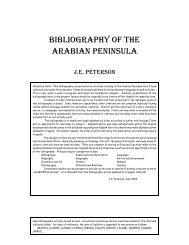THE ARABIAN PENINSULA IN MODERN TIMES: A - JEPeterson.net
THE ARABIAN PENINSULA IN MODERN TIMES: A - JEPeterson.net
THE ARABIAN PENINSULA IN MODERN TIMES: A - JEPeterson.net
You also want an ePaper? Increase the reach of your titles
YUMPU automatically turns print PDFs into web optimized ePapers that Google loves.
out by William Facey. 22<br />
On the other side of the Peninsula, al‐Hijaz has an even more storied past, in part because<br />
the holiest sites of Islam are to be found there in Makkah and al‐Madinah. The early 20 th<br />
century following the demise of the Ottoman Empire, saw the struggle for control of al‐Hijaz<br />
between the Hawashim (or Hashimis, the family that had exercised responsibility for the holy<br />
cities over centuries) and the Al Sa‘ud (the evangelizing expansionists from Najd) in favor of the<br />
latter. This conflict has been dissected in recent decades by Joshua Teitelbaum in his books and<br />
articles, as well as in the articles of William Ochsenwald, Joseph Kostiner, and Suleiman Mousa.<br />
In addition, Hijazi scholar Mai Yamani has examined the persistent lure of Hijazi nationalism. At<br />
the southern tip of the kingdom lies ‘Asir, incorporated into Saudi Arabia in the early half of the<br />
20 th century but previously an independent Idrisi state, as Anne Bang shows. 23<br />
Oman has also received attention from Paolo Costa and myself because its capital, Muscat,<br />
was until 1970 one of the best preserved capitals in the world. 24 The history of its regions has<br />
been largely unexplored, although the survey of Qalhat under the Kings of Hormuz by<br />
Mohammed Redha and Bernadette Bhacker can be mentioned. This is not true of Yemen<br />
where Shelagh Weir has studied the tribes of a far northern part of the country while Paul<br />
Dresch also examines tribal documents in a different area. Two articles look at other areas –<br />
E.J. Keall the faded town of Zabid in the Tihamah and H. Matsumoto a region farther inland. To<br />
the southwest, Linda Boxberger expands on works about the Hadramawt and the far eastern<br />
reaches of Yemen. In the Gulf, Christopher Davidson has explored the explosive growth of<br />
Dubai. 25<br />
University of Michigan, 1992); and Uwaidah M. al-Juhany, Najd Before the Salafi Reform Movement: Social,<br />
Political, and Religious Conditions During the Three Centuries Preceding the Rise of the Saudi State (Reading, UK:<br />
Ithaca Press, in association with the King Abdul Aziz Foundation for Research and Archives, 2002).<br />
22. William Facey, Riyadh: The Old City From Its Origins Until the 1950s (London: Immel, 1992). Facey is also<br />
co-author, along with Gillian Grant, of Kuwait by the First Photographers (London: I.B. Tauris, 1998).<br />
23. Suleiman Mousa, “Sharif Husayn and Developments Leading to the Arab Revolt,” in R.B. Serjeant, R.L.<br />
Bidwell, and G. Rex Smith, eds., New Arabian Studies, Vol. 1 (Exeter: University of Exeter Press, 1993), pp. 36-53;<br />
Joseph Kostiner, “Prologue of Hashemite Downfall and Saudi Ascendancy: A New Look at the Khurma Dispute,<br />
1917-1919,” in Asher Susser and Aryeh Shmuelevitz, eds., The Hashemites in the Modern Arab World: A<br />
Festschrift in Honour of the Late Professor Uriel Dann (London: Frank Cass, 1994), pp. 47-64; Anne K. Bang, The<br />
Idrisi State in `Asir, 1906-1934: Politics, Religion, and Personal Prestige (Bergen, Norway: Bergen Studies on the<br />
Middle East and Africa, 1996); Joshua Teitelbaum, The Rise and Fall of the Hashemite Kingdom of Arabia<br />
(London: C. Hurst, for the Tel Aviv University Moshe Dayan Center, 2001); ibid., “‘Taking Back’ the Caliphate:<br />
Sharif Husayn ibn `Ali, Mustafa Kemal, and the Ottoman Caliphate,” Die Welt des Islams, Vol. 40, No. 3 (2000),<br />
pp. 412-424; ibid., “Pilgrimage Politics: The Hajj and Saudi-Hashemite Rivalry, 1916-1925,” in Asher Susser and<br />
Aryeh Shmuelevitz, eds., The Hashemites in the Modern Arab World: A Festschrift in Honour of the Late Professor<br />
Uriel Dann (London: Frank Cass, 1994), pp. 65-84; ibid., “Sharif Husayn ibn `Ali and the Hashemite Vision of the<br />
Post-Ottoman Order: From Chieftaincy to Suzerainty,” Middle Eastern Studies, Vol. 34, No. 1 (January 1998), pp.<br />
103-122; Mai Yamani, Cradle of Islam: The Hijaz and the Quest for an Arabian Identity (London: I.B. Tauris,<br />
2004); and William Ochsenwald, “Islam and Loyalty in the Saudi Hijaz, 1926-1939,” Die Welt des Islams, Vol. 47,<br />
No. 1 (2007), pp. 732.<br />
24. Paolo M. Costa, “Historical Interpretation of the Territory of Muscat,” in Paolo M. Costa and Maurizio Tosi,<br />
eds., Oman Studies: Papers on the Archaeology and History of Oman (Rome: Istituto Italiano per il Medio ed<br />
Estremo Oriente, 1989; Serie Orientale Roma, Vol. 63), pp. 97-117; J.E. Peterson, Historical Muscat: An Illustrated<br />
Guide and Gazetteer (Leiden: Brill, 2007).<br />
25. E.J. Keall, “Drastic Changes in 16th Century Zabid,” Proceedings of the Seminar for Arabian Studies, Vol. 21<br />
(1991), pp. 79-96; H. Matsumoto, “The History of ‘Uzlah and Mikhlaf in North Yemen,” Proceedings of the<br />
Seminar for Arabian Studies, Vol. 24 (1994), pp. 175-182; Linda Sue Boxberger, “Conflicts of Interests, Contests of<br />
8







